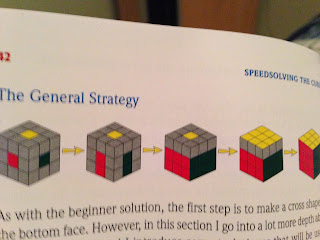In this blog post, I will be talking once again about the 3x3 Rubik's Cube, however this time I will be talking about shortening your time, and getting faster, instead of just solving it. Dan Harris starts talking about speedcubing and decreasing your time when speedcubing. One way to accomplish a faster time is just by solving the cube over and over and over again. This will improve your muscle memory and the more you solve it the better and faster you will be.

Dan Harris talks about another way to drastically improve your time; this is by how you solve it. Harris emphasizes this when he says, "In this chapter I present a wealth of information about an advanced speecubing method known as the CFOP system, which is the system I currently use for speedcubing. This method has allowed me to set personal-best average times of under 15 seconds" (Harris 40). This method was created and invented by Jessica Fridrich of the Czech Republic and is still used today in speedsolving. It is a very efficient way to solve the cube, and using this method, speedcubers, on average, can solve the cube in under 20 seconds.

This may seem new and overwhelming to all of the sudden learn a new way to solve the cube, but if you have already mastered other ways, the algorithms, and the muscle memory will kick in eventually. As Harris stated, each step of the new method requires more memorization than any step in the beginner's method, but if you learn it step by step, you will be familiar with most, maybe all of the algorithms(Harris 40). This is due to the fact that is has the sequence in a sense as the beginner's method however it takes out multiple steps for efficiency.
Question: If you have tried solving a Rubik's Cube, what was your fastest time, and if you wanted to improve it, how much practice did you have to do?
Harris, Dan. Speedsolving the Cube: Easy-to-follow, Step-by-step Instructions for Many Popular 3-D Puzzles. New York: Sterling Pub., 2008. Print.
 My time in the kitchen has come to a close. I learned a lot and I didn't burn down the house. I decided to make chocolate chip cookies as my farewell and i think they turned out okay. Following from the recipe I used "1/2 cup of shortening and 1/2 cup of butter" (Darling 109) start the process of making the cookies. Next, I stirred in flour, sugar, packed brown sugar, vanilla, and chocolate chips (Darling 109). I then put it in the oven which I set at 375 and I left them in there for 8 minutes. After they cooled I tried them and they tasted good. I was surprised they were so good considering they had shortening in it.
My time in the kitchen has come to a close. I learned a lot and I didn't burn down the house. I decided to make chocolate chip cookies as my farewell and i think they turned out okay. Following from the recipe I used "1/2 cup of shortening and 1/2 cup of butter" (Darling 109) start the process of making the cookies. Next, I stirred in flour, sugar, packed brown sugar, vanilla, and chocolate chips (Darling 109). I then put it in the oven which I set at 375 and I left them in there for 8 minutes. After they cooled I tried them and they tasted good. I was surprised they were so good considering they had shortening in it.